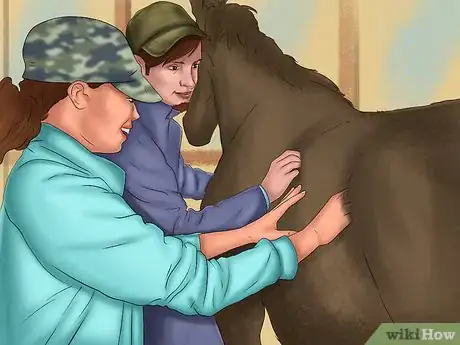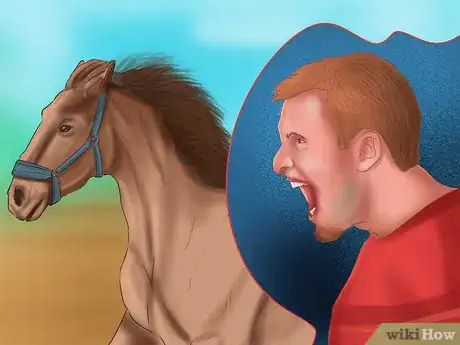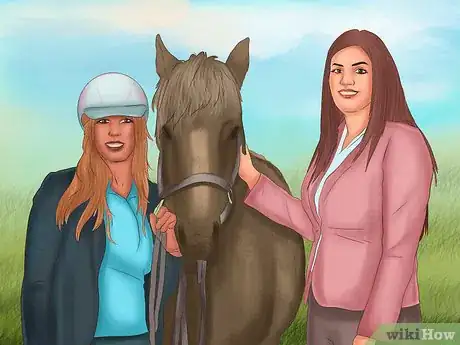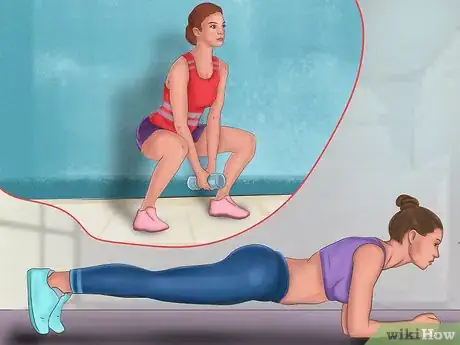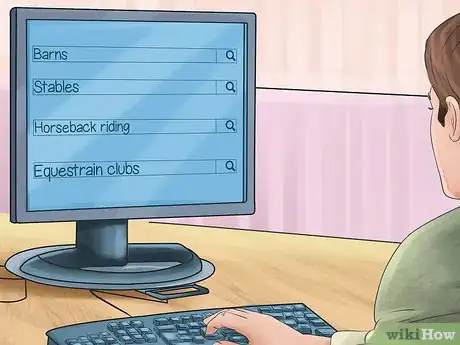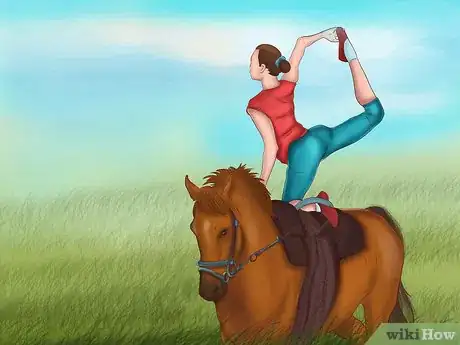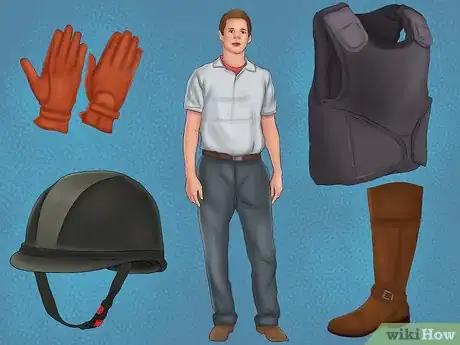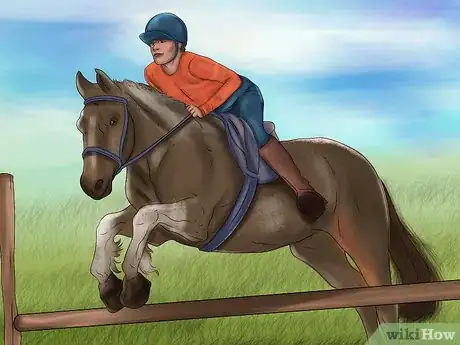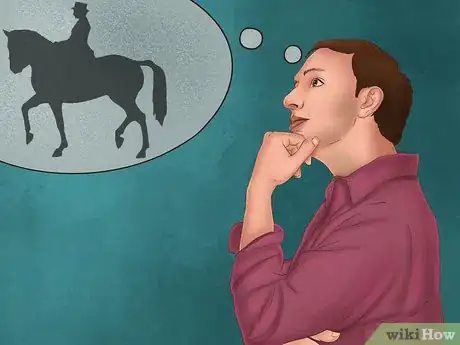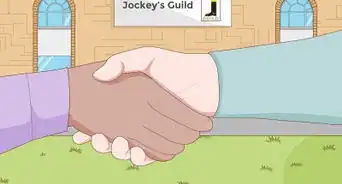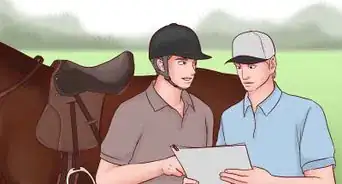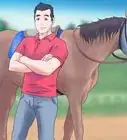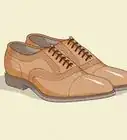This article was co-authored by Jessica Rude. Jessica Rude is an Equine Expert currently working on a cutting horse ranch in Valley View, Texas as well as a horseback riding center in Princeton, Texas. Previously, she was a Trail Guide and Wrangler at a camp and retreat center In Dallas, Texas, and an Equine Breeding Barn Manager at a reining ranch in Tioga, Texas. Jessica holds a Bachelor’s degree in Animal Science with an emphasis in Equine Science from Tarleton State University. She has studied equine nutrition, reproduction, and management. Jessica specializes in equine breeding as well as instructing horseback riding lessons, leading trail rides, recognizing equine illnesses, and administering treatments.
There are 18 references cited in this article, which can be found at the bottom of the page.
This article has been viewed 33,151 times.
Being an equestrian requires a great amount of personal dedication. You will spend both time and money in order to live an equestrian lifestyle. For equestrians, riding is a passion and a sport. To become a true equestrian you will need to immerse yourself in the details of how to properly care and communicate with horses. Choosing a particular equestrian sport, such as dressage, will help you further hone your skills. With practice and the support of a horse-loving community, you can reach your equestrian goals.
Steps
Increasing Your Horse Care Knowledge
-
1Do your research. Learn everything that you can about horses. Go online and look up information about different horse breeds and their characteristics. Watch videos showing horse behaviors. Subscribe to two or three well-known horse magazines. These publications will provide useful information while also letting you know about horse events in your area.
- Being an equestrian requires that you are a life-long learner of all things horse related. Never stop researching or asking questions. For example, if your horse reacts oddly to a certain harness, look up possible reasons online.
-
2Join an equestrian community. Making friends with fellow equestrians at your local barn is always a good idea. They can be excellent mentors for you. Being an equestrian is not a solo activity and you will require the assistance of many people in order to be a success. You can also get involved in equestrian communities online, especially by participating in one of the many horse blog networks.[1]
- If you own a horse and choose to board it, your fellow riders at the boarding stable will become your community. To find a good boarding stable, search online for boarding and training facilities by state. You will want to choose a stable close to your home to make visiting easier. Visit your stable options to assess their cleanliness and general atmosphere.[2]
- You can also build a community by going to a stable for riding lessons. In this case, you will want to very carefully choose your riding instructor. Make sure that they are a member of the Certified Horsemanship Association (CHA). Request references and ask questions about their experience level as well.
- To keep the conversation going, before you head to the barn each day, think about a few questions to ask other riders. For example, you might say, “How long should I cool down my horse after a one hour work-out?”
Advertisement -
3Spend time around horses. Take lessons at a local barn or volunteer to help out at a non-profit stable. If a neighbor owns horses, offer to help them out. You want to spend as many contact hours around horses as possible. Doing so will make you attuned to their behaviors and will help you hone your caretaking and horsemanship skills.
- For true equestrians, riding is only part of the experience. You will also need to get your hands dirty mucking stalls, grooming, and feeding/watering. Don’t shirk these responsibilities or other riders will not take you seriously.
- It is great to own a horse, but make sure that you have contact with other horses as well. Expose yourself to different horse personalities and alternative skill sets. For example, if you are interested in barrel racing, both you and your horse would benefit from spending time with an experienced racing team.
-
4Pay careful attention to the physical and mental needs of horses. As an equestrian, you are responsible for the well-being of the horses around you. Make a daily, weekly, and monthly calendar in which you note major health appointments. Use this calendar to also keep track of how much, and what items, you feed your horse every day. And, keep an eye out for your horse’s mental status. If your horse begins to act out violently or is really lethargic, it may need some extra attention or even a change of stall.
- Treating all health concerns seriously is important for the horse, but also for your safety. Animals in pain are more likely to lash out, injuring their caretakers in the process.
- Get to know all of the equine professionals who care for horses, including veterinarians and farriers. Vets take care of a horse’s vaccinations and dental work while farriers watch over a horse’s all-important hoof care.
- Horses will often take a wide variety of supplements and vitamins. It is important to note what a horse takes in so that you can trace its outward effects.
-
5Respect the animals that you work with. No matter whether you are riding your personal horse or a shared barn horse, you need to treat all animals with the respect that they deserve. Keep calm when working with them and never act out of violence. Count to five if you get frustrated and try the same action once again.
- Take note of the physical strength and size of a horse as well. They can hurt you without even meaning to if you aren’t careful. For example, when you walk beside a horse, watch the placement of your feet. If a horse steps on your foot it can lead to bruises and even fractures.[3]
-
6Serve as an apprentice. Some local horse programs offer formal apprenticeship programs. However, you can usually arrange your own. Find a trainer or horse professional who you admire and feel comfortable working with. Tell them about your interests and ask them to teach you everything that they know. In return, offer to help them care for the horses.[4]
- When you are a more experienced equestrian, make sure that you return this favor by accepting apprentices yourself. Or, even less formally, act like a mentor to younger riders.
Excelling at Equestrian Sports
-
1Stay in shape. Although you hold the reins in your hands, you control your horse by moving your core body. Start incorporating core-strengthening exercises, such as the wood-chopper and plank, into your regular routine. You will be able to ride longer with fewer sore muscles as a result.[5]
- Remember that riding a horse is excellent exercise, but does not include weight resistance. So, it may help you to develop muscles, but will not build bone density.[6]
- If you want an exercise boost, muck out a stall. It provides both cardio and weight resistance.
-
2Get access to a horse. Spending time caring for a horse and working on your riding skills is a necessary part of becoming an equestrian. If you have the resources, you can always purchase your own horse and pay to stable it nearby. If you do not own a horse, go online and search your location along with “barns” “stables” “horseback riding” and “equestrian clubs.” Find a location that fits your price range and schedule and go on a visit.[7]
- To get real results you will need to spend time with horses on a regular basis, more than just once a week. Schedule “horse time” into your calendar and be consistent in attending.
- Some riding locations will allow you to spend time with different horses each week while others will encourage you to stick with the same horse. Ask about the policies before you commit.
- Select equestrian programs at the college level will provide access to a stable of pre-selected horses. If you are interested in joining a collegiate equestrian team, look into this option.
-
3Choose a type of riding. Eighteen styles of riding are currently regulated by the United States Equestrian Federation (USEF).[8] You can focus on western style reining (executing precision loops with your reins while horseback) or even vaulting (holding on to a modified saddle while performing gymnastic moves) or countless other options. Ask your mentors and peers for information, watch equestrian events, and read all that you can about the various sports.[9]
- The standard Olympic equestrian events are: dressage, show jumping, and eventing. Dressage is essentially dancing in sync with your horse. Show jumping involves a horse and rider jumping over various obstacles on a course. And eventing is a combination sport requiring endurance and jumping on untamed terrain.[10]
- Western style riding requires that the horse and rider navigate a variety of obstacles and demonstrate proficiency in corralling.[11] Western dressage riding places an emphasis on a smooth gait and clear communication between horse and rider.[12] Western reining is judged on control during the demonstration of reining patterns.[13]
- Other styles of riding include hunter, which mimics the process of a hunter pursuing prey on horseback, and English pleasure style, which places an emphasis on smooth transitions. You can even focus on carriage pleasure driving, which takes into account a driver’s skill in managing a team or single horse.[14]
-
4Wear the right equipment. Many of your equipment choices will coincide with your sport. Take equipment recommendations from your mentor or other equestrians. If you plan to participate in competitions, make sure to read the guidelines carefully or you could face disqualification or point penalties.
- Remember to invest in a quality helmet. It needs certifications from both the American Society of Testing and Materials (ASTM) and the Safety Equipment Institute (SEI).[15] If you choose to ride competitively and/or often, it is also a good idea to buy a body protector. You wear this vest over your torso and it helps to absorb the energy from a fall or kick. Many different models are available online.
- You will also want to wear some sort of leather shoe, preferably with a small heel. Riding boots are standard for many equestrian sports, although western riders often go with cowboy boots.
- You can purchase riding gloves online or at a local tack shop. Gloves are especially useful in the winter and are also required for some equestrian sports.
- Here is an example of sport-specific dress: General Western style riders prefer leather chaps, cowboy hats, and brightly colored western-themed shirts. Western dressage riders often wear themed-riding jackets as well. In addition to the above, Western reining riders must wear a collared shirt and necktie.[16]
- For safety reasons, try to remove most of your jewelry. If your hair is long, tie it back and secure it under your helmet.
-
5Practice, practice, practice. As often as you can, get out with a horse and practice your intended sport. Do repetitions of the same action so that it becomes second nature for you both. Look for weaknesses and target those areas in particular. For example, some barrel horses don’t like turning left, so it is all the more important to practice that direction.
- It is best to practice at least once a week with a trainer who has experience in your specific sport. If you belong to an equestrian team, it is possible that you will have group lessons as well as individual ones.
- In addition to working out with a trainer, you should practice at least 2-3 times a week on your own. This is yet another reason to choose a stable near your home.
-
6Learn from other equestrians. Go to equestrian competitions and cheer for your peers. Go the barns afterwards and talk with the riders and their helpers. If you are unable to travel to competitions, watch them on TV or stream them live online.[17]
Living as an Equestrian
-
1Do what you enjoy the most. Sit down and do some serious thinking about what you like about horses. Do you enjoy a particular sport? Or, do you find the most happiness out of training horses? Perhaps you really like treating horses for illness? Not all equestrians are the same and you don’t have to compete to be an equestrian. Equestrians love horses and live a horse-centered lifestyle.
- If you are considering a competition sport, you will want to think about whether or not you should stay amateur long-term or transition to a professional at some point. Seek the advice of other trusted equestrians as you make this decision.
-
2Acknowledge the time requirements. Horses require a great deal of care. They will interrupt your daily schedule and will demand attention even on holidays. Look over your daily calendar and consider realistically how much time you have to devote to an equestrian lifestyle.
- This is an especially important to consider if you are thinking about becoming a horse owner. Horses are social creatures and don’t do well cooped up in a stall without visits for long periods of time. This can seriously damage your relationship with your horse and may even put you in danger while riding.
-
3Consider your personal finances. Evaluate what monies you have available to devote to your equestrian pursuits. Being an equestrian can be quite expensive, depending on your specific interests, so you want to be realistic early on. For example, certain sports such as dressage require advanced training that can be rather costly.
- If you are on a limited budget, all is not lost. Look for an riding center that provides long-term or group discounts. You can also offer to work part-time at a facility in order to get additional horse contact hours.
-
4Pursue advanced training. If you decide to become a professional equestrian, whether you take a competition track or decide to be a trainer, you will most likely need to pursue a degree in equestrian studies. Many schools offer both associates and bachelor degrees in equestrian fields. You can gain even more experience by participating in a school’s riding club.[18]
-
5Enjoy the equestrian lifestyle. Every time that you are around a horse do a quick internal reminder that you are here because it makes you happy. You may face difficult moments, but stay grounded in your love for horses and horse culture. This will help you to continue to make the best decisions for you and the horses that you work with.
Community Q&A
-
QuestionWhere is a good riding school at Mudgee?
 Community AnswerTry Wyloona School of Riding. Address: Black Springs Rd., Mudgee, New South Whales 2850.
Community AnswerTry Wyloona School of Riding. Address: Black Springs Rd., Mudgee, New South Whales 2850. -
QuestionWill going to Pony club help me become a good rider?
 Community AnswerYes, as long as it has a a good, certified riding instructor.
Community AnswerYes, as long as it has a a good, certified riding instructor. -
QuestionAre there any good riding schools in europe?
 Community AnswerYes. There are in multiple good riding schools spread throughout Europe. An online search engine is the best way to find the one that suits your needs, as riding schools can sometimes vary between specializations taught and location.
Community AnswerYes. There are in multiple good riding schools spread throughout Europe. An online search engine is the best way to find the one that suits your needs, as riding schools can sometimes vary between specializations taught and location.
Warnings
- Don’t ever treat a horse violently or make it fear you. If you punish a horse harshly, you are creating a situation that could lead to you both being injured.⧼thumbs_response⧽
- Watch out for barn bullying. If someone who you do not respect says negative things about your riding style, etc., do not take their comments to heart. Instead, look for supportive equestrian mentors and peers.⧼thumbs_response⧽
- Be careful and cautious at all times when working with horses. Being an equestrian, especially when sport riding, can be quite dangerous.[19]⧼thumbs_response⧽
References
- ↑ http://equestriancoachblog.com/
- ↑ http://www.thehorse.com/articles/24501/choosing-a-boarding-stable
- ↑ http://articles.chicagotribune.com/2009-01-08/entertainment/0901060230_1_horse-trot-heel
- ↑ http://practicalhorsemanmag.com/article/tips-for-becoming-a-professional-equestrian-11662
- ↑ http://www.horsechannel.com/horse-exclusives/groundwork-core-exercises.aspx
- ↑ http://well.blogs.nytimes.com/2014/09/05/ask-well-is-horseback-riding-good-exercise/?_r=0
- ↑ http://www.accessatlanta.com/news/events/outdoors-recreation/8-places-go-horseback-riding-near-atlanta/nnWMy/
- ↑ https://www.usef.org/filters/welcome.aspx
- ↑ http://www.bbc.com/sport/get-inspired/23150842
- ↑ http://www.bbc.com/sport/get-inspired/23150842
- ↑ https://www.usef.org/_IFrames/breedsDisciplines/discipline/allWestern.aspx
- ↑ https://www.usef.org/_IFrames/breedsDisciplines/discipline/allWesternDressage.aspx
- ↑ https://www.usef.org/_IFrames/breedsDisciplines/discipline/allWesternSSE.aspx
- ↑ https://www.usef.org/_IFrames/breedsDisciplines/discipline/recognized.aspx
- ↑ http://www.horsechannel.com/horse-exclusives/equestrian-helmet-fit.aspx
- ↑ https://www.usef.org/_IFrames/breedsDisciplines/discipline/allWestern.aspx
- ↑ http://www.12thman.com/sports/2015/6/9/EQUEST_0609153219.aspx?path=equest
- ↑ http://www.lovehorsebackriding.com/professional-horseback-riding.html
- ↑ http://olympics.time.com/2012/07/28/equestrian-eventing-the-olympics-most-dangerous-sport/
About This Article
To become an equestrian, research different horse breeds online and subscribe to well-known horse magazines so you can start learning everything you need to know about horses! If you can, you should also spend time around horses by volunteering at a local barn or taking horse-riding lessons. When you start riding horses, make sure you wear the right equipment, like riding boots, gloves, and a quality helmet to keep yourself safe. If you want to be part of an equestrian community try joining an equestrian club though your local barn or starting an afterschool club. To learn how to choose which type of competitive riding is best for you, read on!



